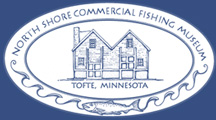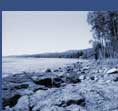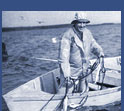 |
    |
|||
About UsMore articles from the North Shore Commercial Fishing Museum Journal
|
North Shore Commercial Fishing Museum JournalAn Old Fashioned Christmas in TofteBy Orton Tofte Sr. Christmas planning started early on the North Shore in the old days. In early fall mothers would order wool yarn, linen, yard goods, thread and buttons. When the Sears Roebuck, Montgomery Ward, and Savage winter catalogues arrived, prices and quality were compared and lists were made. As there were no budget payment accounts, cash had to be acquired and orders changed to reflect good or bad times. Orders were sent, and when the mail arrived the packages were quickly picked up and taken home to be examined and the articles hidden. The wool yarn was usually purchased in Duluth, and when some fortunate lady was able to travel there she usually had many orders from friends and neighbors to fill. Knitting and embroidery began in early fall. Work mittens and heavy socks were made in order to be ready for the first cold weather. Later the fancy mittens and gloves, the wool dress socks, scarves, and caps were made for Christmas presents. The Christmas shirts, blouses, and dresses were made in late fall. The success of the fall herring run determined the final Christmas plans. As money was acquired more orders would be sent. This pace would quicken as the holidays approached. The winter supply of food had to be ordered and put away. Flour, sugar salted meat, dried fruit, crackers, and other staples would be ordered and put away. Most families had gardens that provided potatoes and vegetables to be canned and stored. The family cow provided the mild, cream, butter, and sometimes cheese. The early Thanksgivings were celebrated but not nearly on the scale of today. Turkeys were a rarity, and chicken (home raised) was the rule for Thanksgiving dinner. In mid November the food preparations started. The fruit cakes, light, dark and medium were baked and stored to age properly. Next came the making of the dry lefsa. Several mothers would usually gather and spend a day or more rolling, frying, and storing the many large disks that would be needed for the season. The dried lutefisk would be soaked in a solution of wood ashes and water that was changed often. The first fish that was ready was sampled, and from that day until after the holidays, the silverware would change from its natural color to light blue, then dark blue, and finally black from the wood ash and lye solution. As it was an almost impossible task to keep this silverware bright, no polishing was done until just before Christmas Eve. The pace quickened. Plans were made as to how to get the most perishable items at the last possible minute. The fresh apples, oranges, nuts, candy, oysters, and other good things would be last ordered and the most anxiously awaited. Often the boats would be delayed or not able to get through, and last minute trips via the railroad were taken. This meant a trip to Cramer to Knife River and then to Duluth and usually took several days to complete. The young people were not unaware of what was coming. They examined the catalogues for the very limited choices for Christmas presents. A sled, some new skates, shoes, possible even a new .22 rifle would be wished for. Presents also had to be chosen for parents and friends. Trap lines were planned, trapping territories were claimed, and as soon as the weasel were seen to have turned color, the trapping would start. The weasel would bring from twenty five cents to dollar a piece and each trapper hoped against hope to get at least one mink. A ten dollar mink pelt would ensure the most memorable of Christmases. After the fur buyers made their first call in early December, the catalogue would be taken to the bedrooms and many conferences would take place. The orders would be readied and sent. After a few days the post office would be full of young people anxiously awaiting their packages. Sack after sack of 4th class mail would arrive almost every day, and the postmaster would be treated with special respect in the hope that he would give you your package first. The annual church sale served several purposes. It was the largest money-raising event of the year. It also enabled those who lacked certain artistic skills to purchase the articles of those who were talented. It was a time for the single person to acquire mittens, socks, baked goods, and also presents for their friends. The annual school and church Christmas programs signaled the start of Christmas vacation. It was also the time of work. There were floors to be scrubbed and waxed, rugs to be taken out and beaten, linens to be taken out and ironed, wood to split and stoves to be cleaned. Occasionally a Christmas cookie or some other treat was given that merely whetted the appetite and increased the anxiety. Stories were told of the elves who were watching for good boys and girls. Christmas Eve was the big day when the large meal was served. The family that was fortunate enough to have roast goose was envied. Tables were groaning with breads, rolls, several kinds of lefsa, home-canned vegetables, and a great variety of homemade pickles from cucumber to pear. Later, fruitcakes and the many varieties of cookies, candies, and fresh fruits were served. The Christmas oranges and sometimes bananas were given to the children on Christmas morning. On Christmas Day the young people would start their visiting to compare their presents and to sample the good things at various homes. The round of parties started. The younger members would usually meet at a home in the afternoon to play games. Later in the evening the teenagers would gather to play cards and to visit. Most families would invite friends and neighbors in for an evening of cards and would exchange new and experiences of the season.
North Shore Commercial Fishing Museum Journal Volume 4 Winter 1996 Issue 3 |
|||
 |
||||
|
Plan Your Visit | Events & Programs | Exhibits | Collections | Museum Store | Membership | About Us | Home © copyright 2003, North Shore Commercial Fishing Museum. http://www.commercialfishingmuseum.org web design by homepage design |
||||